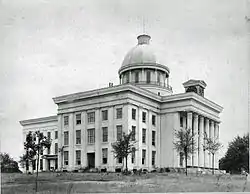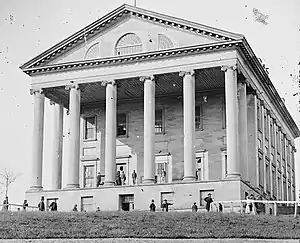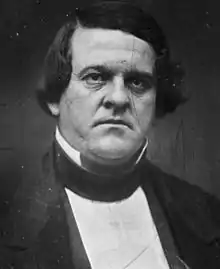Provisional Congress of the Confederate States | |
|---|---|
.svg.png.webp) | |
| Type | |
| Type | |
| History | |
| Founded | February 4, 1861 |
| Disbanded | February 17, 1862 |
| Succeeded by | Confederate States Congress |
| Leadership | |
President | |
| Meeting place | |
 | |
| Alabama State Capitol Montgomery, Alabama Confederate States of America | |
 | |
| Virginia State Capitol Richmond, Virginia Confederate States of America | |
| Constitution | |
| Constitution for the Provisional Government of the Confederate States | |
The Provisional Congress of the Confederate States, also known as the Provisional Congress of the Confederate States of America, was a unicameral congress of deputies and delegates called together from the Southern States which became the governing body of the Provisional Government of the Confederate States from February 4, 1861, to February 17, 1862. It sat in Montgomery, Alabama, until May 21, 1861, when it adjourned to meet in Richmond, Virginia, on July 20, 1861. In both cities, it met in the existing state capitols which it shared with the respective secessionist state legislatures. It added new members as other states seceded from the Union and directed the election on November 6, 1861, at which a permanent government was elected.[1]
First Session
The First Session of the Provisional Congress was held at Montgomery from February 4, 1861, to March 16, 1861.[2] Members were present from Alabama, Florida, Georgia, Louisiana, Mississippi, South Carolina,[3] and Texas.[4] It drafted a provisional constitution and set up a government. For president and vice president, it selected Jefferson Davis of Mississippi and Alexander H. Stephens of Georgia.[1]
Constitutional Convention
The Confederate States Constitutional Convention was held at Montgomery from February 28, 1861, to March 11, 1861.[2]
Second Session
The Second Session of the Provisional Congress was held at Montgomery from April 29, 1861, to May 21, 1861.[2] Members were present from Alabama, Florida, Georgia, Louisiana, Mississippi, South Carolina, Texas, Virginia,[5] and Arkansas.[6]
Third Session
The Third Session of the Provisional Congress was held at Richmond from July 20, 1861, to August 31, 1861.[2] Members were present from Alabama, Florida, Georgia, Louisiana, Mississippi, South Carolina, Texas, Virginia, Arkansas, North Carolina,[7] and Tennessee.[8]
Fourth Session
The Fourth Session of the Provisional Congress was held at Richmond on September 3, 1861.[2] Members were present from Alabama, Florida, Georgia, Louisiana, Mississippi, South Carolina, Texas, Virginia, Arkansas, North Carolina, and Tennessee.
Fifth Session
The Fifth Session of the Provisional Congress was held at Richmond from November 18, 1861, to February 17, 1862.[2] Members were present from Alabama, Florida, Georgia, Louisiana, Mississippi, South Carolina, Texas, Virginia, Arkansas, North Carolina, Tennessee, Missouri,[9] and Kentucky.[10] One non-voting member was present from the Arizona Territory.[11]
Leadership
- President: Howell Cobb
Members
Deputies
Deputies from the first seven states to secede formed the first two sessions of the Congress.
- Richard W. Walker[12]
- Robert H. Smith[12]
- Colin J. McRae[12]
- John Gill Shorter (resigned November 1861)[12]
- Cornelius Robinson (took his seat on April 29, 1861 – Elected to fill vacancy; resigned January 24, 1862)
- W. P. Chilton[12]
- Stephen F. Hale[12]
- David P. Lewis (resigned April 29, 1861)[12][13]
- Nic. Davis, Jr. (took his seat on April 29, 1861 – Elected to fill vacancy)[13]
- Thomas Fearn (resigned April 29, 1861)[12][13]
- H. C. Jones (took his seat on April 29, 1861 – Elected to fill vacancy)[13]
- J. L. M. Curry[12]
- J. Patton Anderson (resigned April 8, 1861)[14]
- George Taliaferro Ward (took his seat on May 2, 1861 – Elected to fill vacancy; resigned February 5, 1862)
- John Pease Sanderson (took his seat on February 5, 1862 – Appointed to fill vacancy)
- James B. Owens[15]
- Jackson Morton (took his seat on February 6, 1861)[16]
- Robert Toombs[15]
- Howell Cobb[15]
- F. S. Bartow (killed July 21, 1861 at the First Battle of Bull Run)[15]
- Thomas Marsh Forman (took his seat on August 7, 1861 – Appointed to fill vacancy)
- M. J. Crawford[15]
- E. A. Nisbet (resigned December 10, 1861)[15]
- Nathan Henry Bass, Sr. (took his seat on January 14, 1862 – Appointed to fill vacancy)
- B. H. Hill[15]
- A. R. Wright[15]
- T. R. R. Cobb[15]
- A. H. Kenan[15]
- A. H. Stephens[15]
- John Perkins, Jr.[17]
- Alexander de Clouet[17]
- Charles M. Conrad[17]
- Duncan F. Kenner[17]
- Edward Sparrow[17]
- Henry Marshall[17]
- A. M. Clayton (resigned May 11, 1861)[18]
- Alexander Blackburn Bradford (took his seat on December 5, 1861 – Elected to fill vacancy)
- James T. Harrison[18]
- William S. Barry[18]
- J. A. P. Campbell[18]
- Wiley P. Harris[18]
- Walker Brooke[18]
- William S. Wilson (resigned April 29, 1861)[18][13]
- Robert Barnwell Rhett[19]
- Robert W. Barnwell[19]
- Christopher Gustavus Memminger[19]
- James Chesnut, Jr.[19]
- William Porcher Miles[19]
- Laurence M. Keitt[19]
- Thomas J. Withers (resigned May 21, 1861 after second session)[19]
- James Lawrence Orr (took his seat on February 17, 1862 – Appointed to fill vacancy)
- William W. Boyce[19]
- John Gregg (took his seat on February 15, 1861)[20]
- Thomas N. Waul (took his seat on February 19, 1861)[21]
- W. S. Oldham (took his seat on March 2, 1861)[22]
- J. H. Reagan (took his seat on March 2, 1861)[22]
- John Hemphill (took his seat on March 2, 1861; died January 4, 1862)[22][23]
- W. B. Ochiltree (took his seat on March 2, 1861)[22]
- L. T. Wigfall (took his seat on March 2, 1861)[22]
Delegates
Representatives from states to secede after the Battle of Fort Sumter were referred to as delegates, in contrast to the deputies from the original seven states.
Notes
- 1 2 Voorhees & Bok 1983, p. 683
- 1 2 3 4 5 6 S. Doc. No. 234, 58th Cong., 2nd Sess. 1904, p. 5.
- ↑ S. Doc. No. 234, 58th Cong., 2nd Sess. 1904, p. 7.
- ↑ S. Doc. No. 234, 58th Cong., 2nd Sess. 1904, pp. 60, 92.
- ↑ S. Doc. No. 234, 58th Cong., 2nd Sess. 1904, p. 193.
- ↑ S. Doc. No. 234, 58th Cong., 2nd Sess. 1904, p. 244.
- ↑ S. Doc. No. 234, 58th Cong., 2nd Sess. 1904, p. 271.
- ↑ S. Doc. No. 234, 58th Cong., 2nd Sess. 1904, p. 337.
- ↑ S. Doc. No. 234, 58th Cong., 2nd Sess. 1904, p. 510.
- ↑ S. Doc. No. 234, 58th Cong., 2nd Sess. 1904, p. 574.
- ↑ S. Doc. No. 234, 58th Cong., 2nd Sess. 1904, p. 701.
- 1 2 3 4 5 6 7 8 9 S. Doc. No. 234, 58th Cong., 2nd Sess. 1904, pp. 12–13.
- 1 2 3 4 5 6 S. Doc. No. 234, 58th Cong., 2nd Sess. 1904, p. 159.
- ↑ S. Doc. No. 234, 58th Cong., 2nd Sess. 1904, pp. 13–14.
- 1 2 3 4 5 6 7 8 9 10 11 S. Doc. No. 234, 58th Cong., 2nd Sess. 1904, p. 14.
- ↑ S. Doc. No. 234, 58th Cong., 2nd Sess. 1904, pp. 22–23.
- 1 2 3 4 5 6 S. Doc. No. 234, 58th Cong., 2nd Sess. 1904, pp. 14–15.
- 1 2 3 4 5 6 7 S. Doc. No. 234, 58th Cong., 2nd Sess. 1904, p. 15.
- 1 2 3 4 5 6 7 8 S. Doc. No. 234, 58th Cong., 2nd Sess. 1904, pp. 15–16.
- ↑ S. Doc. No. 234, 58th Cong., 2nd Sess. 1904, pp. 53–54.
- ↑ S. Doc. No. 234, 58th Cong., 2nd Sess. 1904, p. 64.
- 1 2 3 4 5 S. Doc. No. 234, 58th Cong., 2nd Sess. 1904, p. 97.
- ↑ S. Doc. No. 234, 58th Cong., 2nd Sess. 1904, pp. 638–69.
- ↑ Thomas 1998, p. 32
References
- Root, Elihu, ed. (1904) [1st pub. 1861–1862]. Journal of the Congress of the Confederate States of America, 1861–1865. Volume I: Journal of the Provisional Congress of the Confederate States of America. Senate document (United States. Congress. Senate); 58th Congress, 2nd session, no. 234. Washington: GPO. LCCN 05012700 – via Internet Archive.
- Thomas, Emory M. (1998), The Confederate State of Richmond: A Biography of the Capital, Louisiana State University Press.
- Voorhees, David William; Bok, H. Abigail, eds. (1983). Concise Dictionary of American History. New York: Charles Scribner's Sons. ISBN 0-684-17321-2. OCLC 9111110.
Further reading
- Beers, Henry Putney (1986) [1st pub. Government Printing Office: 1968]. "Chapter II: Congress". The Confederacy: A Guide to the Archives of the Confederate States of America. Washington: National Archives and Records Administration. pp. 9–35. ISBN 0-911333-18-5. LCCN 86008362. OCLC 13425465. OL 2715333M.
- Confederate States of America (1861). Constitution for the Provisional Government of the Confederate States of America. Montgomery, Ala.: Shorter & Reid. LCCN 44014587. OL 24392168M – via Internet Archive.
- Confederate States of America (1861). Laws of the Provisional Congress of the Confederate States in Relation to the War Department. Richmond: Tyler, Wise & Allegre. OL 24601308M – via Internet Archive.
- Confederate States of America (1864). Matthews, James M. (ed.). Statutes at Large of the Provisional Government of the Confederate States of America. Richmond: R. M. Smith. LCCN 06012179 – via Internet Archive.
- Davis, William C. (2002). "Chapter 3: Visions of Breakers Ahead". Look Away!: A History of the Confederate States of America. New York: The Free Press. pp. 55–84. ISBN 0-684-86585-8. OCLC 48711345.
- Martis, Kenneth C. (1994). "Chapter 2: Provisional Confederate Congress". The Historical Atlas of the Congresses of the Confederate States of America, 1861-1865. Gyula Pauer, Cartographer. New York: Simon & Schuster. pp. 7–13. ISBN 0-13-389115-1.
External links
 Media related to Provisional Congress of the Confederate States at Wikimedia Commons
Media related to Provisional Congress of the Confederate States at Wikimedia Commons

.png.webp)